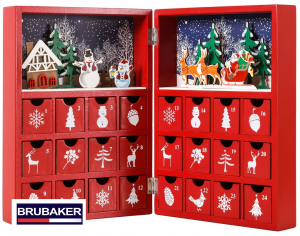
History of Advent Calendars

Counting Down the Magic
When December arrives homes everywhere start to experience delightful events. Kids jump out of bed with extra energy during December mornings as they hurry toward a numbered container that contains a small surprise waiting behind each door. The Advent calendar represents a cherished tradition that brings excitement and happiness during the Christmas countdown period.
A Meaningful Tradition
Advent calendars represent a tradition that extends beyond being just a festive novelty. The tradition of Advent calendars extends through generations as it merges the spiritual essence of Advent with a playful method for counting down the days until Christmas. The Advent season originally began four Sundays before Christmas Day as a period dedicated to reflection. Families practiced the tradition of lighting candles and reading scripture during Advent to prepare their hearts for the celebration of Christ’s birth. During the 19th century Germany experienced a transformation of this serious season into a more visual and interactive practice.

The initial Advent calendars differed from what people recognize as calendars today. Families during Advent would signify each day by drawing a chalk mark on their walls or lighting an extra candle. People crafted handmade Advent calendars featuring religious pictures or notes and cardboard doors that disclosed a Bible verse every day. During the early 1900s in Germany the first printed calendar originated from the work of printer Gerhard Lang. Lang’s calendar design emerged from childhood inspiration when his mother crafted a cardboard calendar with 24 stitched cookies for him. It quickly became a beloved tradition.
Over time Advent calendars gained more popularity while expanding their variety. Simple religious images evolved into imaginative realms featuring chocolates and toys alongside festive illustrations. Modern Advent calendars appear in almost every conceivable format ranging from simple paper and wood calendars to opulent fabric displays featuring premium teas and skincare products. Certain calendars offer miniature wine bottles or craft beers to provide adults with a sophisticated version of the countdown tradition.
Not Just Providing Surprises
Advent calendars serve a purpose beyond providing daily surprises. These traditions create opportunities for reflection and anticipation while adding daily joy throughout the month of December. Each calendar regardless of its complexity or theme demonstrates how Christmas magic exists beyond just reaching December 25th through the daily excitement and meaning we discover.
Modern Advent calendars help families slow down and savor the season, offering small daily surprises—like treats, toys, or messages—that add a touch of magic to the holiday countdown. These brief moments of joy provide a meaningful pause amid the holiday rush.
We have an advent calendar for our family that you can see below. We put a small piece of paper inside each drawer that has an activity we all do together each day. To us, it because important as the girls got older. Brubaker is a fantastic company for beautiful advent calendars of all shapes and sizes. To be clear, we are not affiliated with Brubaker. We just love their items and wanted to share. To see more of their products click here.
Advent calendars serve as more than commercial products by allowing people to express both joy and creativity through their use. Many people create their own versions of Advent calendars which they personalize with unique family traditions and values. Children receive opportunities for altruism through calendars that provide acts of kindness instead of traditional gifts. The countdown becomes a season-long celebration of connection through small activities such as baking cookies, watching a Christmas movie, or writing letters to Santa.
THE WORLD’S AMAZING ADVENT CALENDARS
According to Guinness World Records, the world’s largest advent calendar was built in 2007 at the St. Pancras train station in London. The massive calendar measured 232 feet and 11 inches tall, and 75 feet and 5 inches wide. It was celebrating the reopening of the station following a renovation.
For several years, LEGO has produced a calendar set, featuring figures or constructible accessories behind every numbered door. This year (published in 2010), the company is offering a City version and a Star Wars Advent calendar.
Since 2008, the Big Picture photo blog has featured an Advent calendar of daily images from the Hubble Space Telescope. The spectacular photos are chosen by Alan Taylor, The Atlantic‘s senior photo editor.






